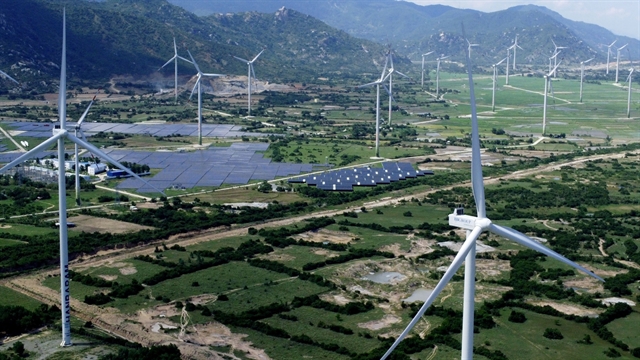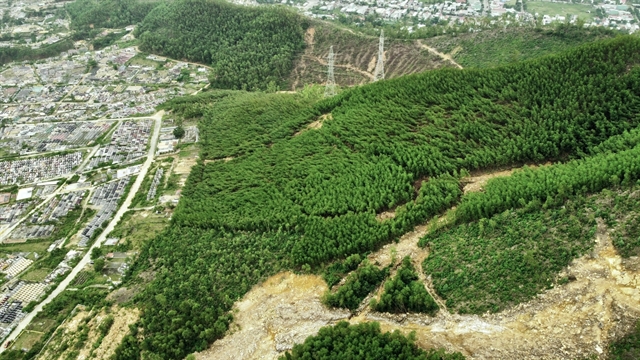 Economy
Economy

 |
| A solar power project in Thuận Nam District, Ninh Thuận Province. The nation has set ambitious climate targets, including a non-binding net-zero goal by 2050, with a 2030 emissions target of 781 metric tonnes of carbon dioxide equivalent, up from 458 in 2020. VNA/VNS Photo Huy Hùng |
By Mai Hương
In the midst of an ongoing global shift towards sustainability, Việt Nam has emerged as one of regional leaders in Southeast Asia's green economy transition. This leadership is not just about setting ambitious goals, but also about demonstrating measurable progress.
The Southeast Asia’s Green Economy 2024 report, recently released by Bain & Company, GenZero, Standard Chartered and Temasek, underscores Việt Nam's advancements, highlighting the nation's leap in the green economy index.
Việt Nam’s rise by five spots in the index reflects substantial improvements in its roadmap for a green economy. This is a testament to the country's commitment to bridging the gap between green aspirations and actual progress.
At the heart of Việt Nam's green agenda lie robust commitments.
The nation has set ambitious climate targets, including a non-binding net-zero goal by 2050, with a 2030 emissions target of 781 metric tonnes of carbon dioxide equivalent, up from 458 in 2020.
Việt Nam's progress includes expanding forest land, reducing emissions per capita to 4.7 tonnes, achieving 43 per cent renewable energy in power generation, attaining 3 per cent battery EV sales, and curbing tree loss by 14 per cent.
To accelerate this transition, several mechanisms are in place.
Power Development Plan VIII (PDP8), introduced in May 2023, outlines a comprehensive strategy to phase out coal by 2050, while significantly increasing the contribution of solar, wind and hydroelectric power to the national grid.
Another critical component of Việt Nam's strategy is the Just Energy Transition Partnership (JETP), which plans to draw in US$15.5 billion in investment. This partnership emphasises the importance of public-private collaboration in accelerating the green transition.
Additionally, the country is developing carbon pricing instruments and an Emissions Trading System, slated to become operational by 2028. This initiative, led by the Department of Climate Change under the Ministry of Natural Resources and Environment, is a critical step towards reducing greenhouse gas emissions and creating a market-driven approach to carbon reduction.
Emissions reporting is currently mandatory for sectors, but there's a lack of a permitting process for renewable energy electricity. Việt Nam also lacks a carbon market registry and Voluntary Carbon Market standards. Initiatives like a developing carbon tax and incentives for EVs, solar power, and green buildings are underway, yet challenges persist in attracting sufficient private investments.
Despite requiring a capital investment of $34 billion for its green transition, Việt Nam secured only $200 million in private investments in 2023.
 |
| The acacia plantation in Hòa Vang District, Đà Nẵng City. Đà Nẵng is considering planting native forest trees as part of Việt Nam's afforestation efforts. VNA/VNS Photo Văn Dũng |
Việt Nam experienced a dramatic 79 per cent decline in private green investments in 2023. This drop is largely attributed to delays in executing major national roadmaps and the high cost of capital, which ranges from 10 per cent to 12 per cent. This financial strain underscores the urgent need for timely policy implementation and the creation of a favourable investment environment.
Regulatory uncertainties further complicate the situation. Delays in the implementation of key policies such as PDP8 and JETP have hindered large-scale investments. Additionally, Việt Nam provides fewer financial incentives and subsidies for decarbonisation compared to other regions. This lack of support affects corporate willingness to invest in green technologies.
In response to these challenges, Việt Nam is making strategic adjustments. The country is updating its feed-in tariffs for wind and solar projects and offering incentives for electric vehicles and green building construction.
The Ministry of Planning and Investment is also spearheading an initiative to transform 563 industrial parks into eco-friendly zones by 2030. This move aims to engage companies focused on decarbonisation and to create sustainable industrial hubs.
Additionally, in 2023, Việt Nam launched its first voluntary carbon exchange, marking a key step in its carbon reduction efforts. By 2025, the country plans to pilot a comprehensive carbon exchange system to create a robust platform for carbon trading, enhancing its ability to meet emission targets and foster a carbon credit market.
Việt Nam’s progress is notable compared to its ASEAN peers.
Singapore leads the way with a robust sustainability framework, including a carbon tax and strong incentives for green technologies. It climbed four spots in the green economy index. Thailand has made notable progress in solar power but faces similar regulatory and financial obstacles. Indonesia and Malaysia have seen mixed progress, dealing with regulatory ambiguity and high capital costs, each moving up by two spots on the index.
The region confronts a significant investment gap, requiring $1.5 trillion to finance its green transition by 2030. Urgent collective action from governments, corporations, and investors is essential. Standardising regulations, mitigating investment risks, and fostering a conducive environment for green investments through regional collaboration are crucial.
Southeast Asia's success in its green transition relies on collective efforts to embrace commercially viable green technologies, while unlocking economic benefits for a sustainable and prosperous future. VNS




